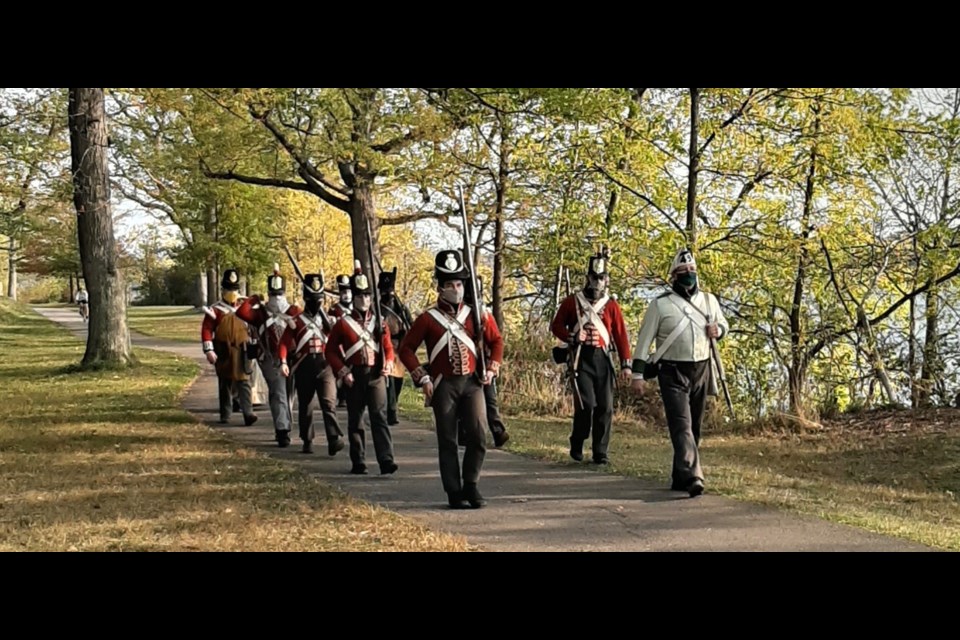Back in 2012, Sgt. Ryan Clark, Quartermaster of the 49th British Grenadiers Reenactment Group, participated in the 200th anniversary of the Battle of Queenston Heights. Included in the commemoration was a march from Fort George to Queenston Heights, the same march British forces would have undertaken to reinforce Queenston after the American forces invaded the area.
Anticipating such an attack, Major General Sir Isaac Brock stationed British troops at strategic locations along the river. On Oct. 13, 1812, the news of the American invasion reached Fort George. Brock left on horseback to take command of the British forces at Queenston. The Americans captured the Redan Battery and Brock was killed leading a counterattack to regain this strategic location.
British Major General Roger Hale Sheaffe arrived with reinforcements from Fort George. These troops marched the 10-kilometre trek from the fort to Queenston to join the battle. As Clark explains, “upon their arrival, they climbed to the top of Queenston Heights and different British units (49th and 41st) along with Canadian units (2nd Regiment of York Volunteers) and Native Allies fought against the invading U.S. forces.” Eventually, the American army collapsed and surrendered.
The historical texts end the battle there, with tallies of dead soldiers and American prisoners, but Clark believed that was not the end of the story for the soldiers. After participating in the anniversary march he felt more connected to the soldiers who had fought in the battle 200 years ago. Those troops that marched from Fort George to Queenston, fought a battle, won a victory, then marched back to the fort.
Clark, who has been involved in reenactments for more than 20 years, decided to do the march again solo in 2017. He recalls, “The first year was just me seeing if I could do it, and if it was a viable thing that others would do.” He had only planned to recreate the march from Fort George to Queenston as they had done in 2012, but being on his own, once he made it to the top, he then had to turn around and march back to Fort George.
Since then, Clark has been joined by other participants who have also made the annual trek from Fort George to Queenston Heights and back, wearing their full uniforms, complete with wool trousers, tunics and carrying their muskets. In past years, he was happy to welcome any and all participants to the event, but this year Clark capped the number at 15 to observe pandemic precautions and physical distancing. “This might be the only event some reenactors do this year, so I wanted to make sure some could participate.”
For this year’s march, he was joined by members of different reenactment groups from across Ontario, including Samuel Challen, Harrison Burrill, Thomas Taplay, Rob McGuire, Abel Land, Jody Ethridge, Zane Scott, Jordan Kipp, James McFarlane, Joel Culliford, Craig Burney, and Susan Piper aided by two support vehicles driven by Virginia Hurley and Leigh Ann Culliford. There was also one lone American soldier, Thomas Walters, who, according to Clark, “paddled from the U.S. to the Canadian coastline but never touched land.”
The group left Fort George shortly after 9 a.m. on Saturday, took a short rest at McFarland House, then on to the Queenston World War memorial and a detour to the docks to set eyes on their American “foe” before ascending to Queenston Heights.
They arrived at their destination shortly before 1 p.m., where they enjoyed a rest and some lunch (tack) before making the 10-kilometre trek back to the fort.
During the break, reenactor and ex-military Jody Ethridge, described the physical and philosophical meaning of the march for him. “It is one thing to read about it in a history book, but to actually put on the gear and march here and fight a full battle and march back — they were made of some pretty stern stuff.”
Clark added that the soldiers of 1812 did not have the luxury of a nice paved pathway, stairs, and support vehicles.
In the shadow of Brock’s monument, the troops turn in formation to begin the march back to Fort George. For Clark, it is this return trip that holds the greater significance. Remembering when he first descended from Queenston Heights as a lone soldier in 2017, he becomes more reflective. “The march back came to symbolize those that did not make the march back; that made the ultimate sacrifice,” he laments. “I came to honour those that couldn’t return.”
He adds, “We do it for those that couldn’t.” One can imagine battle weary soldiers in heavy wool tunics burdened with the weight of their gear, the weight of the souls of their lost comrades upon them.
“It is important to remember those that fought and died defending Canada,” says Clark. “We would not be Canadians now without those who defended Canada back in 1812. I hope to teach people along the way about what happened here over 200 years ago, and to be proud of being Canadian.”
Clark encourages anyone who is interested in this or other reenacting events to go to this website (www.recruiting.crownforces.ca).



